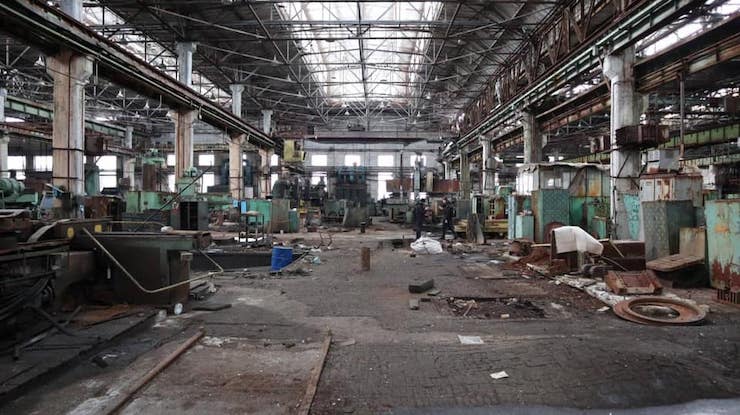A Ukrainian state-owned, 139-year-old industrial giant -- ironically named Bolshevik – was sold for UAH 1.43 billion ($52 million) on 27 October 2021. Situated in Kyiv’s city-centre, the factory will be converted into “an innovative space.” This is the first instance of large-scale privatization (a deal valued above $10 million) in Ukraine.
More than 3,000 auctions for small privatization have taken place in Ukraine since 2018 -- the year reform of privatization started. But the burgeoning wave of large privatization could generate, in one year alone, three times as much revenue for the state as small privatization has altogether.
Often overlooked, privatization of inefficient entities bulks up the state budget, boosts local economy, and contributes to the GDP. On the other hand, it also empowers new business magnates who do not necessarily have a spotless reputation, but do have money to spend.
A thorny way to privatization
Privatization is associated with an exceptionally abusive period for Ukrainians; many carry painful memories of the 1990s, the early post-Independence years. Poor regulation of privatization at the time allowed a small number of individuals to concentrate shares of former state enterprises into their own hands. These are the origins of the powerful oligarchs who plague the nation to this day.
Going forward, the solution to corruption does not lie in cementing all of the remaining state-owned enterprises into state ownership. Currently, about 3,000 state-owned entities remain in Ukraine. Half of them are not generating profit; instead they account for some UAH 170 billion in losses. This is a heavy burden for Ukrainian taxpayers. With the exception of some economically strategic targets, privatizing ineffective state enterprises benefits budget revenues, eases state debts, and generates taxes and employment.
- Read more: Ukraine eyes a second Big Privatization of state enterprises. The oligarchs are eyeing it, too.
To conduct privatization in an open, transparent competition -- and not repeat the failings of the controversial 90s -- major reforms of privatization have been put in place. In 2018-2019, two key laws were adopted: “On Privatization of State and Municipal Property” and “On Lease of State-Owned and Municipal Property.” As of late 2018, state property can only be sold through e-auctions conducted in the Prozorro.Sale system, where participation is not restricted and anyone can compete.
Results of 2018-2021 small-scale privatization
Small-scale privatization has been carried out successfully in Ukraine for the last three years. Encompassing enterprises and other assets valued at less than UAH 250 million ($10 million), to date the policy has bolstered the budget by close to UAH 5 billion ($200 million).
of the landmark Dnipro Hotel in downtown Kyiv. With a starting price of UAH 80 million, the hotel was sold for UAH 1,111 million. Overall, 29 companies bid for it. The hotel was purchased by Oleksandr Kohanivskyi, founder of world-renowned Ukrainian e-sports club NAVI (formerly Na'Vi).

Kohanivskyi stated that Dnipro will be the first hotel in the world to be fully prepared for e-sports events. He publicly outbid local oligarchs Serhiy Tihipko and Stepan Chernovetskyi, as well as several major investors, which demonstrates the transparency of contemporary privatization.
The state has also set clear conditions for privatization of every kind of entity or article. In the Dnipro case, conditions included preserving the internationally known name of Dnipro for the hotel, as well as continued employment of its staff, at no less than the current level.
Large-scale privatization unleashed
If the commodity in question is worth more than UAH 250 million (at initial valuation) it is deemed to fall under the rules of large-scale privatization. These sales must involve professional advisers who -- in addition to overseeing pre-auction criteria -- are also responsible for seeking out potential investors.
The system of large privatization was temporarily blocked during the 2020 economic crisis to avoid the inequitable sale of under-valued assets. It was unblocked by Parliament on 30 March 2021.
The heavy burden of factory Bolshevik that the state has thrown off
The selling of the Bolshevik factory became the first case of large-scale privatization in Ukraine. Technically it is a victory — instead of huge losses and debts, the state received $52 million and will potentially receive additional revenue in the form of taxes. At the same time, critics claim that the evaluation of the factory could have been two times higher had the state waited a few years to resolve judicial disputes. The ongoing court disputes for part of the property had the effect of undermining the factory’s commercial status, discouraging potential investors from participating in the auction.

At the time of purchase, 80% of factory annual revenues were gained from rental of the premises -- only two out of 36 workshops were still operating. The factory was unprofitable and had debts of at least UAH 500 million. Still, located on 35 hectares of valuable land in the center of Kyiv, it was purchased for UAH 1.43 billion — a price exceeding the opening bid of UAH 1.39 billion.

Dmytro Sennychenko, head of the State Property Fund of Ukraine, commented on the minor increase in purchase price by saying that the initial price was already high, considering the factory’s huge debt, court battles, and outdated facilities.
He lists all the encumbrances that winners of the auction have inherited, along with the valuable land and facilities in the center of Kyiv:
- Equipment worth little more than being completely obsolete, with the average age of machinery at 48 years;
- Unprofitable enterprise, needing constant additional maintenance costs;
- An obligation to transfer part of the equipment of special significance to the Ukroboronprom (state defense industry) free of charge;
- The need to preserve the balance of specialized production and invest UAH 57 million in it;
- Repayment of UAH 500 million in debt. In particular, unpaid social tax due to which Bolshevik employees cannot obtain their pensions;
- UAH 150 million in fines and penalties that will accrue immediately after payment of tax debts;
- Costs for transfer of equipment to the additional facility in the town of Zhashkiv, maintaining production there and compliance with social guarantees and trade unions.

Transparency International analyst Khrystyna Zelinska names
in her report similar drawbacks, stating the purchase of the factory was quite risky for investors, considering the volume of encumbrances and ongoing court hearings.
The factory was purchased by companies jointly held by three business owners, Oleksiy Baranov, Vasyl Khmelnytskyi, and Andriy Ivanov. The three investors say they will create “an innovative space” out of the existing building but did not elaborate on the details.
Six amazing projects bringing life to Soviet ruins in Ukrainian cities
Deal criticized for low bidder participation
In total, three companies bid for the factory, with the starting price increasing only slightly at 2%, during the auction. Some 10-15 potential investors who had considered the purchase decided not to participate in the competition. Ukraine’s Antitrust Committee said it will review whether the auction complied with all norms of competition.
Other potential investors said
they decided not to compete because of an ongoing court controversy. It turned out that at the time of auction, one of the three buyers, Khmelnytskyi, was suing the factory over a disputed piece of land. Therefore, if another bidder had won, they would face outstanding court battles against Khmelnytskyi -- without the possibility of developing a project covering the entire parcel of land -- while Khmenlnytskyi had simply purchased, thereby eliminating, any possible dispute he might have faced in court.
Formally, Khmelnytskyi did not violate any rules, rather he put in place a years-in-advance planning scheme. The court hearings had discouraged other investors from participating in the auction.
Opposing the criticism, head of the State Property Fund of Ukraine Dmytro Sennychenko, stated that the auction was entirely fair despite the low level of competition. Some 1,200 pages of audit reports (apart from the several thousand pages of primary documentation of the company) were uploaded to virtual data storage and immediately became available to all interested parties in advance. Although non-disclosure agreements were signed by 17 companies that had spent many hours and legal fees to study materials on the privatization asset, only three of them decided to participate in the auction.
Sennychenko also affirmed that the investors who acquired the company were thoroughly reviewed by the SBU and the Foreign Intelligence Service -- primarily to exclude the possibility of Russian capital. However, Andriy Ivanov, business partner of Vasyl Khmelnytsky and co-owner of the firm which purchased Bolshevik, was accused of smuggling and tax evasion by investigating journalists. No investigatory or judiciary proceedings were conducted on this matter.
Perspectives
Summarizing, although privatization provides revenues for the budget and contributes to a stronger economy, the state has little influence over who will purchase what. Not always amenable to the public, this issue can hardly be managed. The much needed judicial reform -- the most lagging in Ukraine’s reform policies -- could best address this issue.
The upcoming auction in the framework of large privatization -- scheduled for 20 December 2021 -- will involve the sale of the United Mining and Chemical Company, which conducts the extraction of titanium ores and owns several mines. In total, the state is considering 23 enterprises for large privatization. According to Dragon Capital, the six most valuable of them are the following:
- Centrenergo, producing and providing electricity, its three thermal power plants produce 15% of the capacity of electricity in the country.
- United Mining and Chemical Company, one of the world’s largest producers of rutile and zircon concentrate.
- Odesa Port Plant, major chemical enterprise.
- Kharkiv Oblenergo, electricity distribution, commercial energy, and accounting services.
- Khmelnytskyi Oblenergo, electricity distribution for citizens of Khmelnytska Oblast.
- Sumykhimprom, production of mineral fertilizers, coagulants, additives to cement, acid, titanium dioxide, pigments and other chemical agents.
Read also:
- Ukraine eyes a second Big Privatization of state enterprises. The oligarchs are eyeing it, too
- Ukrainian government sets ambitious goals for privatization of state enterprises
- The biggest problem of Ukraine’s economy and six enthusiasts who solved it
- Why can’t Ukraine just get rid of its oligarchs?

